Description of the procedure
A vasectomy is a surgical procedure that provides men with a method of permanent birth control by making them sterile. The procedure prevents sperm from mixing with semen, so when a man ejaculates during sexual intercourse, the semen does not contain sperm and cannot make a woman pregnant.
When should this procedure be performed?
Doctors perform vasectomies once and the result is permanent.
Why is this procedure performed?
A vasectomy provides men with a permanent and reliable method of birth control. It is a valid option for those who do not wish to father more children, who are unable or unwilling to use other types of birth control, or who have a partner for whom pregnancy is unsafe due to a medical condition.
Are there any risks and precautions?
Certain risks are common to all surgery and every time a local or regional anesthetic is used. These risks depend on many factors including the type of surgery and your own medical condition. The possible, but very rare, side effects include: side effect of the anesthetic, breathing problems, infection, and bleeding.
Although a vasectomy is generally considered safe, it does have some risk of side effects or complications. These include:
- blood clot in the scrotum (also called a hematoma)
- bleeding or bruising of the scrotum
- buildup of fluid inside the testicle, which can cause pain during ejaculation
- infection
- inflammation around the testicles
- pain
- pain or discomfort of the scrotum
Very rarely, it is also possible that the tubes that carry sperm will rejoin, allowing sperm to enter the semen and making the man fertile again.
Vasectomies do not protect you from sexually transmitted infections (STIs) such as HIV/AIDS, chlamydia, or genital herpes. Abstinence and wearing condoms are still your best protection against STIs.
Vasectomies do not affect testosterone levels, nor do they lower a man's sex drive. The ability to achieve and maintain an erection and to ejaculate are also not affected by a vasectomy.
If you are concerned about any symptoms following this procedure, speak to your doctor. Take the time to be sure you understand all the risks of complications and side effects as well as any precautions you or your doctor can take to avoid them. Be sure your doctor understands all your concerns.
What happens during the procedure?
Vasectomies are usually performed in a doctor's office under local anesthesia on an outpatient basis. There are two different methods for vasectomy.
In the first method:
- Your doctor makes an incision on one side of the scrotum.
- Your doctor then locates the tubes (vas deferens) that carry sperm from the testes (where sperm is produced) to mix with semen.
- The vas deferens is tied in two spots and then cut between the ties.
- The ends of the tubes are then sealed.
- Your doctor may then sew up the incision.
- This process is repeated on the other side of the scrotum.
In the second method (commonly referred to as the "no-scalpel" vasectomy):
- Your doctor will locate the vas deferens through the scrotal skin and then clamp them in place.
- Using a sharp instrument, your doctor will make a small puncture in your scrotum.
- This opening is then gently stretched wider.
- Through this opening, the vas deferens is pulled out, clamped, tied, cut and the ends sealed, similar to the first method.
The advantages of the "no-scalpel" vasectomy are that there may be less pain, tissue damage, bleeding, discomfort, and risk of infection. As well, since the incision is small, stitches are not necessary.
The procedure generally takes about 20 to 30 minutes to complete. There is no guarantee that a vasectomy can be successfully reversed.
How should I prepare for this procedure?
Before having this procedure, discuss the advantages, disadvantages, long-term risks, and consequences associated with the procedure with your doctor. Be sure you fully understand what will happen and are comfortable with your doctor's answers to your questions.
Your doctor may advise you of certain things you can or cannot do before the procedure. Follow your doctor's recommendations.
Tell your doctor or prescriber about all prescription, over-the-counter (non-prescription), and herbal medications that you are taking. Also tell them about any medication allergies and medical conditions that you may have.
Ask your doctor or pharmacist whether you need to stop taking any of your medications before the procedure.
You may also be asked to clean and shave your scrotum before the procedure and to bring along a clean jock strap that you can wear after the surgery for scrotal support.
Arrange for someone to take you home after the procedure.
What can I expect after the procedure?
Initially after the procedure, the scrotum will be numb from the anesthesia. This is normal and goes away after a few hours. Minor discomfort or pain in the area may continue for a few days after the surgery. You may also experience some swelling and bruising, which should go away within 2 weeks. Ice packs, medications for pain, and a scrotal support can help with discomfort.
Follow all your doctor's instructions. Try to avoid any strenuous activities and sports for about a week after the surgery. Most men are able to return to work 2 to 3 days after the procedure. After approximately one week, or when your body feels ready, sexual activity can resume.
Sperm count decreases gradually over time after the procedure, therefore it is recommended that you or your partner use another form of birth control initially. You should discuss this with your doctor. You will have a follow-up sperm count test about 2 months after the surgery. It may take 2 to 3 months before your semen is clear of any sperm.
Fever or swelling that does not go away or problems with urination may indicate a problem. Speak to your doctor as soon as possible if you notice these symptoms.
Results
When performed successfully, a vasectomy is over 99% effective as a means of birth control.
All material copyright MediResource Inc. 1996 – 2024. Terms and conditions of use. The contents herein are for informational purposes only. Always seek the advice of your physician or other qualified health provider with any questions you may have regarding a medical condition. Source: www.medbroadcast.com/procedure/getprocedure/Vasectomy


